Like they say, there are a lot of fish in the sea! Out of all those fish in the sea, the pencil fish could be one of the most unusual fish you will ever see.
The pencil fish is a teeny tiny freshwater fish that belongs to the pipefish family. This fish has over sixty species, and they vary from each other based on their looks and ever-interesting colors.

This tube-ish and slender fish species can be found in Mexico and Thailand. It spends its time happily feeding on planktons. It has two barbels that help them in feeding on planktons. And what is even more interesting is that this fish swims upside down.
No wonder this fish has drawn the attention of numerous fish keepers worldwide using its appearance and colors.
Table of Contents
Pencilfish Care
Taking care of the pencilfish is a little challenging. Due to its extreme sensitivity, this fish is frequently prone to irritations in habitats and temperatures that change. It is essential to keep the surroundings clean, and the ideal recommendation is to replace the water in the tank your pencilfish inhabits by at least 25 to 50 percent every other week if it is highly crowded and dense.
Pencilfish Overview
| Information Chart | Pencilfish |
|---|---|
| Scientific Name | Lebiasinidae |
| Family | Characin family Lebiasinidae |
| Care Level | Easy |
| Temperament | Peaceful |
| Color | Yellow, Red Maroon, etc. |
| Lifespan | 4 to 5 years |
| Size | 1.5 to 2 inches in length |
| Diet | Zooplankton and other teeny tiny invertebrates / Omnivorous |
| Minimum Tank Size | Zooplankton and other teeny tiny invertebrates / Omnivorous |
| Minimum Tank Size | 5 gallons |
| Temperature | 72- 78 °F (22-26 °C) |
| Water Conditions | 5.0 – 8.0 pH and 9 to 20 dGh |
| Tank Mate Compatibility | Community tank, compatible with tetras, rasboras, etc. |
Pencilfish Appearance
This fish has a long body and it is sharped at the muzzle. The pencilfish can achieve maximum growth of 3 centimeters and can live approximately five years. It has a broad-lined appearance, thanks to the two horizontal black stripes on its wonderful red body. The lower part of the body is a bit paler or even white than the rest of it. Usually, the males are pretty much paler that the females and the other difference between them is the white blotch at their bottom dorsal fin. When they procreate, the males’ whole body becomes a lot brighter.
The difference between males and females can also be noticed by their behavior where the females are more obedient than the males.
Origin of Pencilfish

Near Santa Elena, particularly in the river Rio Tigre and in Peru – river of Rio Nanay this species was first spotted. It was first described and discovered by Arendt and Paepke in the year of 2001. The Pencilfish cannot be found on the IUCN Red List. It is also recognizable by the names of Peruvian Red Pencilfish, Ruby Red Pencilfish or Red Arc Pencilfish.
They can be seen in shoals, keeping their territory bravely. They eat mainly annelid, arthropods, coelenterate, and other animals that lack backbones in their natural habitat.
The Lifespan of Pencilfish
The life expectancy for this tiny fish species is about 4 to 5 years.
However, if you stay on top of its maintenance, you will be able to extend its lifespan even further.
Pencilfish Size
A pencilfish can grow up to 3.5 cm (1.5 inches).
Pencilfish Care and Tank Setup
To keep a Pencilfish, it is recommended that you have an intermediate experience in fish keeping because it is a little bit complicated to take care of this species. It is a very sensitive fish, so when it comes to changing environments and temperatures it is often prone to irritations. The best advice is to try and acclimatize it in a quarantine tank before placing it in its everlasting home.
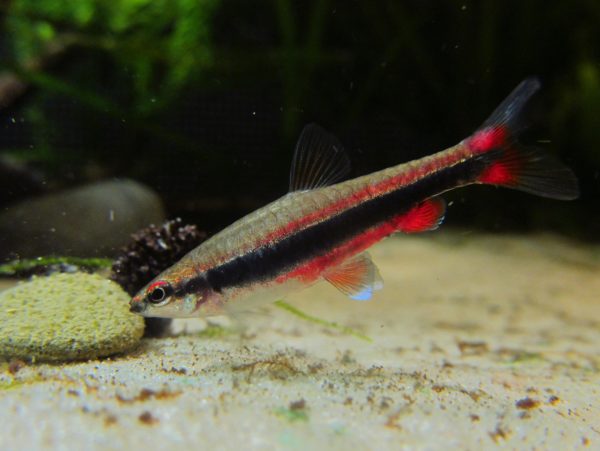
If the tank your Pencilfish lives in, is very crowded and dense, the best advice is to change its water from 25 to 50 percent minimum every second week. Nonetheless, it is crucial to maintain a clean environment for each one of your species that you are taking care of.
Pencilfish Tank Size and Specifications
Optimum Tank Size for Pencilfish
Acidic and soft water will greatly help them to adapt faster. It is best to use a peat filter. The best size is about 29 gallon tank. The Pencilfish is quite an active swimmer and it will swim mostly on the top of the aquarium. If it sees an opportunity, it will try to jump so it is a must to cover the fish tank.
Filter Type
You need to install canister filter, as pencilfish like clean water, but due to their relatively small size they cannot withstand a greater water flow.
If you have a medium or a big tank, you can use canisters, and an internal filter will function just right if your tank is small.
Substrate
Adding dark sand to the bottom of the tank as a substrate will provide the Pencilfish to achieve its greatest coloration. Good planted and floating herbs will add to the atmosphere a lot. The Pencilfish loves hiding in the décor that is placed into the fish tank, for example it loves resting near some driftwood decorations.
Water Parameters for Pencilfish
Water Temperature
Recommended temperature is from 22 to 27 Degrees Celsius or 72 to 78 degrees Fahrenheit.
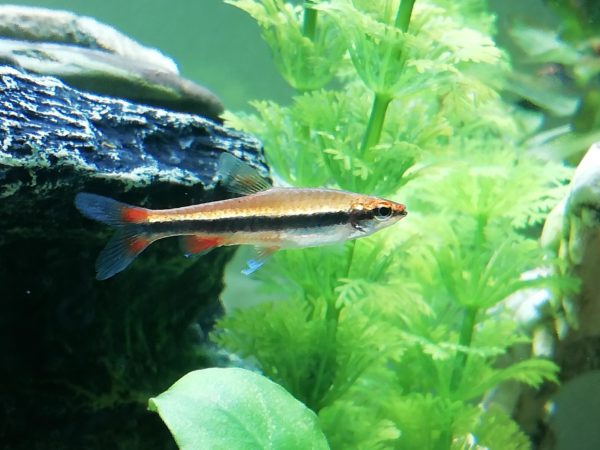
pH Level
The pH of the rank should range from 5.7 to 7.0.
Water Hardness
The water hardness is from 3 to 10 dGH. In a tank with low lightning, your Pencilfish will be calmer.
Pencilfish Tank Landscapes
Best Plants for Pencilfish Tanks
Some of the best plants available for your pencil fish tanks are – riccia, pistia, and water lettuce! These are the best because these plants give the fish their natural habitat, and they feel very safe.
Or you may opt in for common vallisneria or gigantean (tape grass). These are very thick and act as good hiding spots.
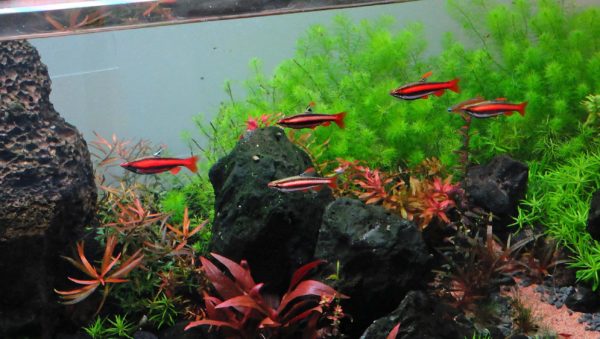
To keep them in your tank, you should maintain the parameters. You should maintain a pH of 5.0 to 8.0, a temperature of 72 to 78 degrees Fahrenheit, and the water hardness should be between 18 to 226 ppm.
Worst Plants for Pencilfish Tanks
Some of the plants that can be very much toxic to your Pencilfish are –
- Bleeding heart
- Caldium
- Cherry
- Castor bean
- Foxglove
- Lily-of-the-valley
These plants are way toxic for your fish! It would be better, if you do not try to put these plants in your tank.
Decorations for Pencilfish Tanks
Replicating an ideal habitat can help the fish to thrive fully!
In its own natural habitat, the Pencilfish gather in a group near the shores, where they find thick aquatic fauna!
They would be happy if you provide them with the same conditions!
Use plants that have thin leaves, a bit of low lights will be enough for your fish to live happily!
Lighting for Pencilfish Tanks
When it comes to lighting, pencil fish does not prefer bright lights. Adding some plants to the tank can help you get a proper ambiance.
Now if you wish to put lights in the tank, it is always better to go with lowlights!
Feeding Pencilfish
Although it has a certain habit in the wild to feed on zooplanktons and little invertebrates, when it is placed in captivity, it will generally eat any kind of food. It is an omnivorous fish that means that it does not have a picky character when it comes to nourishment.
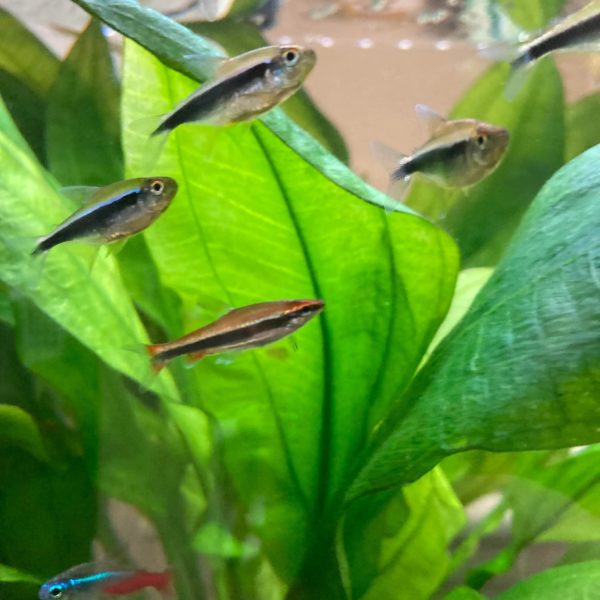
Best Diet for Pencilfish
It will enjoy eating little pellets, cooked fish food, flake food, frozen food, dry food and anything eatable by fish in general. With an occasional treat of frozen or live small animals like brine shrimps and bloodworms, it will achieve its best appearance and coloration. Take a note that the Pencilfish has a very small mouth, so its food has to be offered smashed or blended to avoid injuries or choking. The frequency of feeding should be a few times a day.
Pencilfish Behavior and Temperament
The Pencilfish can live as a single or in a group with its kind, where it will feel pretty comfortable. Best number to make a group is 6 fish or more. It is highly recommended to keep more females than males in one aquarium, to prevent the aggression between the male rivalries. Too much antagonism will stress the females, so reduce the number of male Pencilfish.
Interestingly, this fish is not aggressive with different species, so it is considered a good tank mate. Considering this fact, better place your Pencilfish in an aquarium with smaller fishes; hence they cannot win fighting over food with larger species. If this situation is overlooked, the Pencilfish can easily die from hunger.
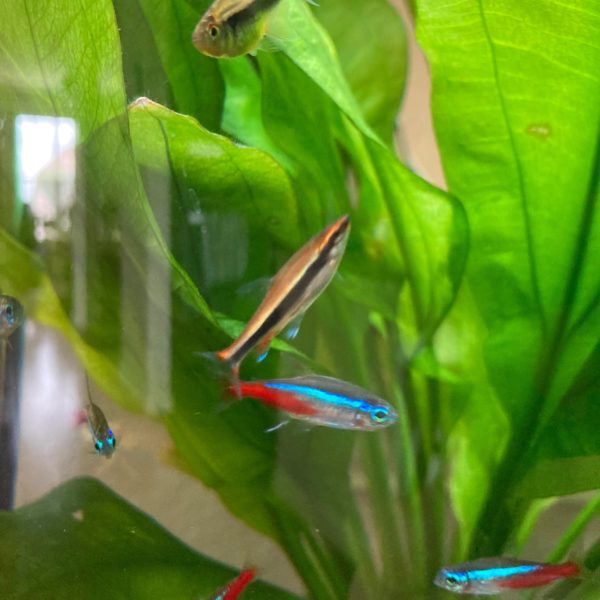
Is Pencilfish Lone or Societal?
Pencilfish are pretty outgoing, and they are one of the best choices for small community tanks!
Pencilfish Compatibility and Tank Mates
The Beckford pencil fish is special for its calm and peaceful nature. They are relatively small in size. And this is why these fish are not kept with bigger fish!
If you keep them with big fish, they will see the pencil fish as something to feed on. So, you must keep them away from tanks with predators and aggressive fish species. Overly active fish species like the tiger barbs can be a problem.
Otherwise, the pencil fish can cohabitate with dwarf cichlids like the Apistogramma. Other compatible tank mates can be rasboras and other species of characters.
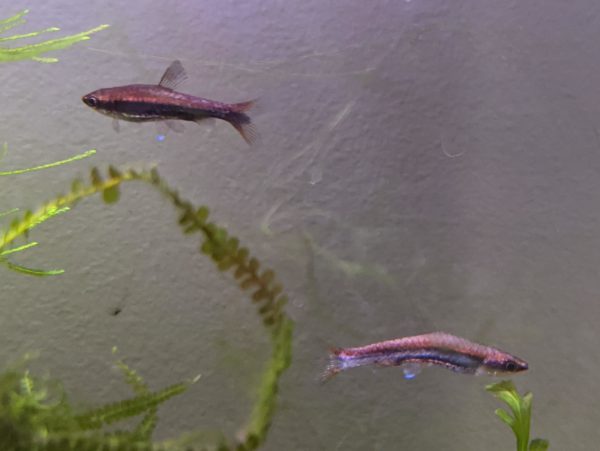
Also, your pencil fish can flourish better when kept in a school of 10 of their kind. The bigger the group, the better you get to observe their behavior.
Ideal Pencilfish Tank Mates
Some of the most compatible tank mates for your pencil can be –
- Cherry Barbs
- Tetras
- Rasboras
- Dwarf Gourami
- Corydoras
- Mollies
- Bristlenose Pleco
- Swordtails
Bad Tank Mates for Pencilfish
Pencilfish is peaceful and pretty calm, and they will get stressed if you put them together with humongous fish species. And it is worth taking a note that you cannot keep Pencilfish with overly active fish species such as the tiger barbs.
Here are some of the bad tank mates for pencilfish –
- Tiger barbs
- Angelfish
- Parrot fish
- Oscars
Any fish that can grow more than the Pencilfish can be a potential threat.
Breeding Pencilfish
A lot of aquarists had success in the procreation of the Pencilfish. The first thing you should keep in mind is to have the best possible water conditions. In a very dense planted fish tank, the risk that the eggs will be eaten is huge so you can try spawning them in a different aquarium filled with acidic and soft water.
While breeding, the males will be very aggressive and territorial so it is best to spawn them in pairs. Try putting one pair if you have a smaller nano tank. If you have an additional larger tank of 10 gallons, you can do multiple pairings there. The tank has to be quite planted with vegetation and does not have to be very bright because the fish is very sensitive to light. From herbs, you can provide java moss, nylon spawning mops where the eggs can be laid, or clumps of wool.
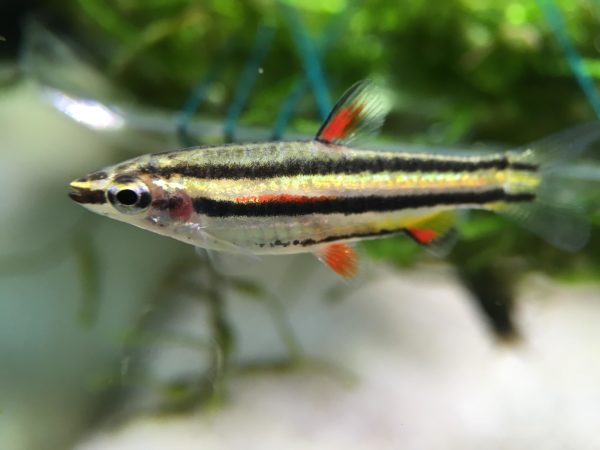
The best temperature for reproducing is around 23 Degrees Celsius with a pH of 6.7 and hardness of approximately 2.
The active breeders should be fed for about 7 to 10 days with live food. Then, the spawning will begin. The female lays from 25 to 30 eggs. Afterwards, the parents should be removed and the tank has to be kept dark. The eggs hatch in about 35 hours, and three or four days later try to swim on their own.
You can feed the fry with brine shrimp and micro worms.
Pencilfish Breeding Level – Intermediate
Breeding Guide
So, let us get started with the breeding process –
1. Setting Up the Tank
If you have been in this profession, I hope you have known by now that you cannot breed your fish in regular tanks. You would need separate tanks. A separate tank that can hold 10 to 20 gallons of water should be fine.
Lighting plays a crucial role in this, so make sure you provide the tank with dim light. Using high-powered lights can make the plan go south, so play it safe. You can use dim light bulbs. Use some good-quality aquatic plants and substrates.
If you are not willing to use substrate, dark construction paper works fine. Now, choosing plants can be difficult for you, as not every plant will have the ability to provide a homely environment.
Choose the plants that have fluffy leaves, like the dwarf ambulia. The plants with fluffy leaves work incredibly well when hiding the eggs and fry.
Also, you can use the java moss as it helps protect the fry.
2. Install a Sponge Filter
Installing a sponge filter is crucial for the tank. The biological filtration is already there and reinforcing the tank with a secondary sponge filter enhances the oxygenation in the tank.
3. Filtration
In this step, you must filter the water. If you want, you can do it by adding some blackwater extract to the tank or using peat.
During this process, the water in the tank should have a temperature of 25 degrees Celsius or 77 degrees Fahrenheit.
4. Transfer the Fish to Breeding Tank
After setting the tank up completely, it is time to get moving. Before moving up the fish, remember to follow the 1:2 ratio, i.e., one male for two females.
If you wish to increase the probability of success, add a school of twelve into the tank, out of which 4 will be males, and the rest 8 will be females. After transferring the fish to the tank, increase the water temperature to 29 degrees Celsius or 84 degrees Fahrenheit.
5. Feeding
Feeding during the breeding can be very confusing, but not anymore!
You can try feeding them Drosophila or any other small insects with a soft body. You can expect the procedure to start once the fish in the tank feel nourished and the water has reached the appropriate temperature.
At the start, the males will try showing off to the females. As the process builds up, the males will drive the females more into the plants in the tank. As the male drives her, there will be a time when the female will eject eggs, and the male will fertilize the eggs.
Right after the eggs are fertilized, the eggs turn delicious, which the parents would enjoy, and some feed on their laid eggs. To safeguard the eggs from such an act, you should plant, as the plants will hide them from the eyes of their parents.
Again, to protect the eggs, you can use a marble substrate. As the parents lay and fertilize eggs, they will fall into some locations, making it hard for the parents to reach.
6. Remove the Egg Layers
Once the breeding process is completed, you need to remove the parents immediately.
The fertilized eggs will be hatching within 35 to 36 hours, about a day and a half. Then, you have to arrange for food to feed the fry.
You can feed micro worms and brine shrimps to the fry.
Pencilfish Sexual Dimorphism
You can identify the males with the help of their shape and are brilliantly colored. You can determine the sex of the fish by analyzing the color of their fins!
The fins of the males are very brightly colored!
Pencilfish Common Diseases and Their Treatments
The Pencilfish is prone to protozoa, skin flukes, worms, bacterial infections and diseases. Anything you add into the aquarium may cause illness. It is best to reduce the stress, hence the stress is the main indicator for sickness.
So, achieve the best environmental conditions to make them feel like they are in their natural habitat and you will have no problem to raise healthy and happy fish.
Preventing the disease is way better than treatment! Yes, stress can cause many problems to your fish, and one such condition is poor water quality. Poor water produces skin diseases and bacterial infections such as ich. These diseases can severely damage your fish’s immune system!
If any fish is infected with such diseases, try quarantining them in a small tank! It is treatable, and regular water change can reduce its effects! If you find no improvement, you may seek medical care.
The best preventive measure is to conduct weekly water changes. Yes, just renew 25%of the total water from the tank every week! And clean the tank at least once a month!
Facts About Pencilfish
- This is an omnivore and will feed on anything, be it marine worm or flatworm. It can also feed on tiny amphipods. This fish is not of those picky fish, and if you provide anything that can fit in its mouth, your fish will happily eat them.
- It looks great but also looks kind of peculiar at the same time. Compared to its body size, it has a bigger mouth. The snout helps them to search for food.
- The fish’s body is in a cylindrical shape and is covered with teeny tiny scales that sort of look like pencil erasers. These fish have a pale-yellow body with black strips on each side.
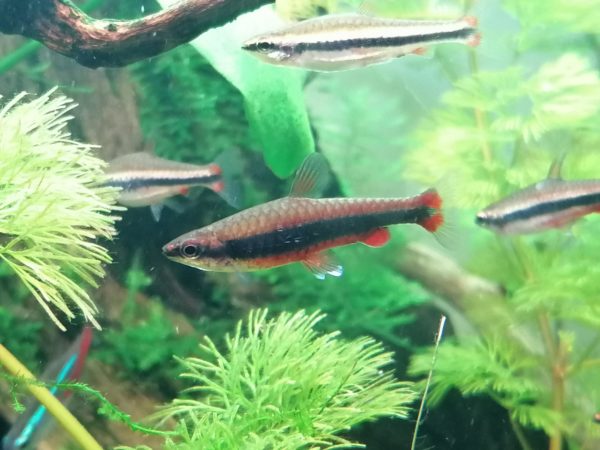
Is Pencilfish Right for You?
Yes, these are easy to keep, take a minimum amount of care, adapt to various water conditions, and are very peaceful. And most importantly, they are not picky when it comes to food.
It is a lovely fish and is fun to watch when kept in a group of 10.
Frequently Asked Questions
What To Feed Your Ruby Red Pencilfish?
There is nothing to worry about when feeding your newly bought ruby red pencil fish. These fish will eat anything other freshwater fish do, such as flakes, live foods, etc.
You may give pellets, cooked foods, frozen or live foods. You may also think of including greens such as lettuce, etc.
You have come up with a properly balanced diet to help your fish achieve its best coloration. This fish is known for its interesting colors.
Are The Pencil Fish Easy to Pet?
Yes! One of the factors that makes the best choice for beginners is their hardy nature! No wonder it could be the best aquarium fish you will ever pet.
These are peaceful, happy, accept most types of food, can adapt to various water changes, and are very easy to pet!
Are Tetras and Pencil Fish the Same?
Both tetras and pencil fish belong to the same order called Characiformers. They belong to the family called Lebiasinidae.
They share the same family, but they are pretty different from each other!
Here is how you will be able to identify tetra – tetras have pretty long, slender fins and a fatty finn. (Adipose fins are between the caudal and dorsal fins.
You cannot find the adipose fin on pencil fish.
Conclusion
Many people feel tense when it comes to breeding their favorite fish. And this is normal as many do not know how to deal with the parents and handle the fry.
But, as you read this article till the end, you will know that it is easy and takes time. Now, if you take the process seriously and follow each step sincerely, you will be able to breed your fish!
Keep the factors in check, such as water temperature, food, and proper oxygenation, and you are ready to go!
Good luck!
